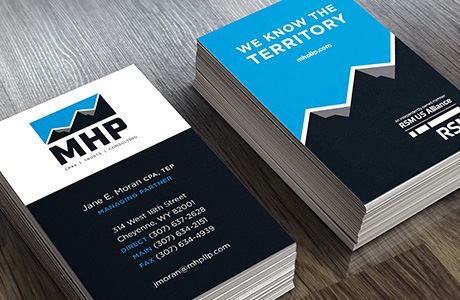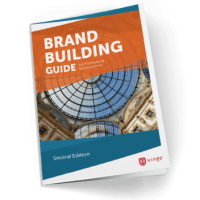Today, I’m going to explain how to create an effective tagline for a professional services organization.
We are exposed to taglines every day. Some are timeless and express a brand so perfectly that they are almost interchangeable with a name. Here are a few classics from the consumer world I’m sure you’ll recognize:
- “Got Milk?”
- “I’m Lovin’ It”
- “What’s in your wallet?”
- “Fly the friendly skies”
- “Just Do It”
Good taglines seem so simple and obvious. And that is their magic. But creating that magic isn’t as simple as it appears.
Most firms don’t think about taglines in any systematic way. One day they decide they need to “come up with” a tagline, and that is where things typically go sideways.
As Hinge’s Director of Business Development, I have a lot of conversations with professional services firms. They come to us to solve their largest marketing and branding challenges. So I’ve talked with hundreds of leaders and marketers of firms large and small. I’ve gotten to know their competitors. And I’ve seen a lot of taglines.
Most are bad.
Really bad.
Here’s how the process typically works. A firm gathers an internal team to brainstorm a page full of options—only to realize that nothing quite lives up to expectations. Looking for the next “The king of beers,” they find themselves with the jack of squat. Frustrated, they reach out to some really creative friends. A cascade of ideas follows, but still no winner. Eventually the group settles on something like this:
“Your Trusted Advisor”
That’s cool. Same as every other firm in their industry.
What Is a Tagline, Anyway?
A tagline is a short phrase used to reinforce a key aspect of a firm’s brand. It goes by many names (in the UK, for instance, they call it a strapline), and it can range from witty to straightforward.
In the context of professional services firms, a tagline is usually an integral part of a firm’s brand identity (as opposed to an advertising slogan)—and it often appears in conjunction with the firm’s name and logo.
Do You Need a Tagline?
Does your firm need a tagline? The answer will depend on whether it can help you solve a larger problem. Do your prospects struggle to understand what you do? A tagline can provide clarity. Do want to differentiate your firm from similar competitors. A tagline may provide a highly visible hook to hang a key differentiator on. Do you want to communicate a value or characteristic of your firm in a concise, aphoristic way? Again, a tagline could help you achieve that goal.
But not every firm needs a tagline. If you are already well known, for instance, a slogan might just be unnecessary brand noise. Or you may need to solve more urgent problems first, such as figuring out how to differentiate your firm or how to get out of the commodity business and sell more high-margin services. Many firms do just fine without a tagline, so don’t think you have to have one just because your top competitor does.
Three Types of Taglines (with Examples)
One reason professional services find it difficult to develop a tagline is that they don’t understand what a tagline can—and cannot—do.
A tagline can accomplish one of three things:
It can describe what you do
Examples: “The program management specialists” and “The Land Lawyers”
This approach can be helpful if your firm is not well known or people don’t understand what you do. We call literal taglines like these “descriptors.” Some firms employ both a descriptor and a tagline, choosing which to use based on the context. For instance, Cherry Bekaert, the 2024 fastest-growing top-100 accounting firm, uses its marketing tagline “Your guide forward” in most applications, saving its descriptor, “CPAs and advisors,” for entering new markets where people may not be familiar with their name and services.
It can convey a benefit of your service or your market position
Examples: “The accessible CPAs” and “IT. Without the anxiety.”
Our client, MHP, worked with us to rebrand and develop new collateral that would help them enter new markets adjacent to their home state of Wyoming. Their tagline “We know the territory” shows prospective clients that they are knowledgeable while playfully tipping their hat to the region’s history.

It can attempt to convey an emotion or aspiration.
Examples: “Imagination at Work” and “Do more”
“Just Do It” and “Think Different.” Smitten by these iconic slogans from Nike and Apple, many firm leaders want a tagline that delivers a similar punch. What they fail to remember, though, is how many millions of advertising dollars it takes to turn a few simple, vivid words into a household catchphrase.
Of course, professional services firms don’t necessarily need to embed themselves in the nation’s psyche. But that doesn’t mean this type of tagline is easy to pull off. In fact, it can be quite risky. Because they are so abstract, these taglines often fail to resonate with anybody. For this format to be successful—without a Superbowl ad budget—a tagline must both support a firm’s positioning and create an emotional tie to its target audience. This sort of tagline, then, requires that you deeply understand your audience, usually informed by research.
Whichever kind of tagline you develop, don’t expect it to do too much work. Most taglines can convey one simple idea. (There are exceptions, such as the popular but somewhat generic triad taglines, such as “Collaborate. Perform. Achieve.”) Unless you have a huge advertising budget, your tagline will always play a marketing supporting role.
How to Develop a Tagline
You can approach tagline development from a couple of angles. If you have done audience research, start there. Are there any particular strengths you might want to feature? Did you uncover any surprises? Was there anything that clients said that separates you from your competitors? Why did they choose you over another firm? If you have access to the verbatim responses, were there any interesting words or phrases respondents used to describe you? Research can provide a treasure trove of insights to inform your tagline.
If you don’t have access to research (and even if you do), think about your strategic challenges. What is the one idea or benefit you want to convey about your firm, your culture or your services? At the same time, review your positioning and look for a major theme you might want to inject into your tagline.
Start a list of your ideas. Don’t worry about turning them into compact phrases yet. Once you have at least a few ideas, look at the three types of taglines above and see where yours might fit. If your firm name describes what you do, you may not need a descriptor-style tagline. For example, The International Finance Corporation doesn’t need a tagline to convey what business it’s in (spoiler alert: it’s international finance).
Now it’s time to start eliminating ideas. Are there any weak candidates you can knock out from the start? Next, try to articulate the big business challenge you are trying to overcome with your tagline. (Note: this may be different from your biggest overall business challenge. For instance, you probably aren’t going to address your talent shortage problem with your tagline.) Weed out any candidates that don’t apply to this challenge.
Once you have winnowed your list down to one to three ideas, start turning them into tagline phrases. Shorter is almost always better. So pare away unnecessary words (do you need that “The” at the beginning?). Experiment with different phrasing. Use a thesaurus to flush out more elegant-sounding words.
Think about how you can make the phrase stick in the mind. Would alliteration help? How about humor (be careful!)? Wordplay? Is there a common idiom you can adapt or twist to your purposes?
Aim for a tagline that is two to five words long. Extra bonus points if it is on the shorter end of that range.
Once you have something you feel good about, ask yourself a few tough questions:
- Is it too predictable or trite?
- Are you saying something that your competitors aren’t?
- Is it too abstract? Would the reader need to know some insider knowledge to make sense of it?
If you can answer yes to any of these questions, you have more work to do.
Tagline writing is an art, so if you struggle with it don’t fret. Consider hiring an experienced professional to help.
Protect Your Investment
You have invested a lot in your tagline, so you may want to make sure it won’t be subject to legal challenge. And if you plan on putting your tagline on expensive physical items like stationary and building signage, you definitely do not want to skip this step. Like names, taglines can be subject to lawsuits if another business believes it infringes on their trademark. While anyone—even you!—can conduct a trademark search using the Patent and Trademark Office’s trademark search tool, be aware that it takes a great deal of expertise to fully vet a tagline. If you are serious about protecting your tagline, we recommend hiring an experienced IP attorney to conduct a full search and register your trademark with the federal government.
Example of a Tagline Project
As part of a branding project with Jones CPA Group, we used research and a crystal clear message to create a powerful and approachable brand. Our research revealed the trait that clients valued above all others was their accessibility and friendly, engaging style. So we ran with it. The tagline, “Let’s talk success,” was just one way we expressed this theme.

Final Thoughts
A tagline should describe what you do, who you do it for or how you want your audience to feel about your firm. Keep it simple and brief. And as you address a key business challenge or theme, try to balance creativity with practicality.
Also, remember that it takes time and exposure for a tagline to gain traction. Repetition and association with other relevant messaging and imagery can give it even greater power. Try to imagine the reaction back in 1988 when a forward thinking agency first introduced “Just Do It” to a conference room of executives in Beaverton, Oregon. No doubt, it took courage and an open mind to embrace it. The rest is history.
How Hinge Can Help
Develop rebranding strategies that better connect with existing clients and prospects. Hinge’s Branding Program can help your firm stand out from the competition and build a brand that drives sustained growth.
Additional Resources
- Our most recent Rebranding Kit gives you the tools and knowledge you need to lead your firm through a rebranding.
- Get strategies, tips, and tools for developing your firm’s brand with Hinge’s Brand Building Guide for Professional Services Firms.
- Our free Differentiation Guide for Professional Services Firms guides you through how to build a powerful differentiation strategy.


